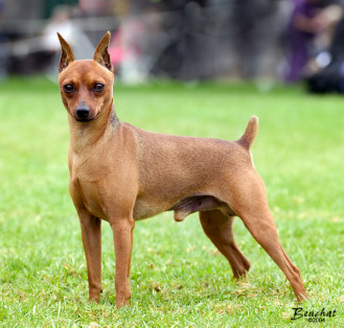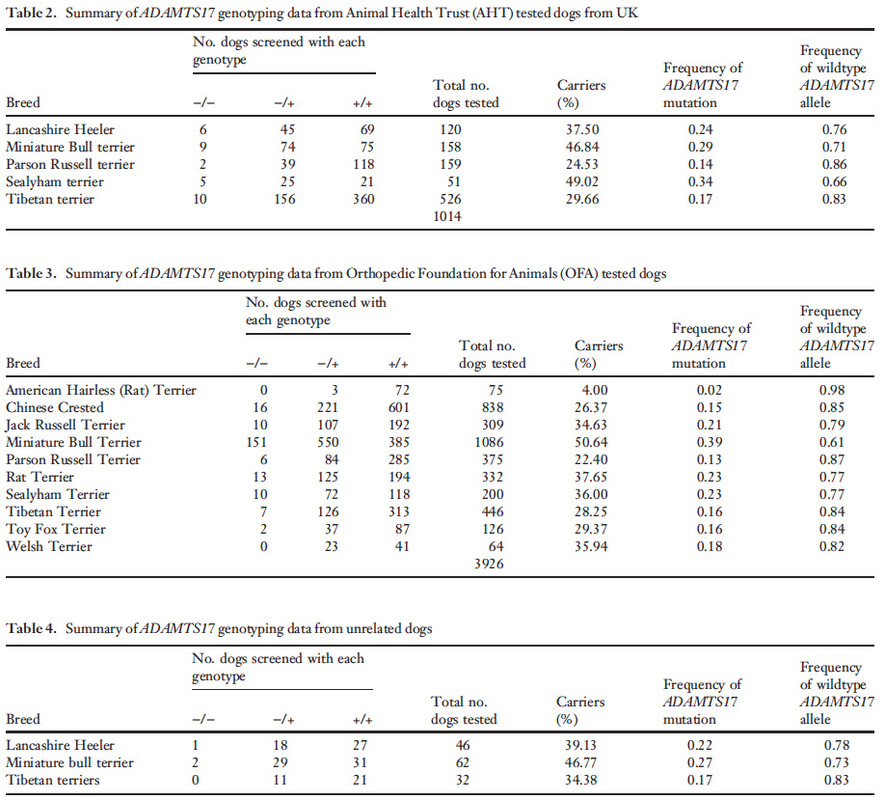
I ran into a paper about primary lens luxation in dogs today, and the phrase "widespread among dog breeds" in the title caught my attention. Naturally, I wondered exactly how widespread we're talking about here. To get right to the meat of things, have a look at this table, which reports carrier frequencies by breed. (These are data for US dogs, but the reported numbers for dogs in the UK are very similar; I've included the entire table at the bottom of the post, and note that there additional affected breeds listed below.)
American Hairless Terrier - 4%
Chinese Crested - 26%
Jack Russell Terrier - 35%
Miniature Bull Terrier - 51%
Parson Russell Terrier - 22%
Rat Terrier - 38%
Sealyham Terrier - 36%
Tibetan Terrier - 28%
Toy Fox Terrier - 29%
Welsh Terrier - 36%
With the single exception of the American Hairless, these numbers are shocking. Carrier frequencies are all in the double digits for every other breed, and for a disorder that (might) be autosomal recessive there are plenty of opportunities to unwittingly produce homozygous (i.e., eventually blind) puppies. Almost 30% of Tibetan Terriers are carriers, and for Minibulls fully half have the gene.
http://www.offa.org/dnatesting/pll.html), but if you're a Minibull breeder are you going to check this page if there is no indication on the OFA breed page that the disorder is an issue?
OFA has statistics for results of the testing they have done (http://www.offa.org/stats_dna.html?dnatest=PLL), and from this some additional breeds need to be added to this list, among them the Australian Cattle Dog (~30% carriers among the dogs they tested), Bull Terrier (29% carrier, and 43% "at risk", whatever that means), Miniature Pinscher (25% carrier), Norwich Terrier (6% carrier), Pumi (7% carrier), and a few other miscellaneous breeds.
The nice thing about diseases caused by recessive alleles is that as long as the allele is rare in the population, a homozygous case will appear only rarely. As the frequency of the allele increases - for example as a consequence of a prolific popular sire - the chances of producing affected dogs likewise increases. A bit of linebreeding would be all it would take to result in a sudden, horrible epidemic of blindness in a breed. And by the time the breeders know what hit them, they are faced with having to breed around their carriers, which now amount to a substantial fraction of the population. It's a real bummer.
Breeders have no way to know that this disaster is headed their way. The rate of affected dogs in all of these breeds is very low, except for the Minibull (the fraction affected in the US is about 13%, and the breed club is aware of the problem). (You can do these calculations yourself - divide the number of homozygous dogs by the total dogs tested in the tables. So for US Minibulls, 151/1086 = 0.139, or 13.9%.).
But- there's a wrinkle. Lens luxation is easy to diagnose - the fibers that keep the lens suspended in inside the eye break, and the lens falls out of position. Anybody with an eye scope can see this. So among the dogs examined in this study, there is 100% certainty that all dogs have a luxated lens. But there are some disturbing incongruities between the genotypic and phenotypic information. There were some clinically affected dogs that were heterozygous for the suspect allele, as well as some that didn't carry the mutation at all (including Shar Pei and Brittany). It would seem that there is an additional risk allele involved, or an entirely different unknown mutation. So the available genetic test isn't foolproof, and in fact dogs tested as carriers (or even clear?) could nevertheless become affected. I did a check of the scientific literature and didn't find any papers published subsequent to this one that might offer additional information about these possible complexities.
The question I have to ask is why OFA isn't treating a disease gene with a carrier frequency of 20-50% in multiple dog breeds as worthy of mandatory testing. Or at least a mention of this information on the breed page so the "reputable" breeders that would err on the side of doing more tests than they absolutely need to will at least be made aware. Perhaps the respective breed clubs can do a bit of homework and make some recommendations to OFA about providing this information. Although eventually, of course, the number of affected dogs will start increasing and the cat will be out of the bag.
This publication is behind a journal paywall. If you would like a copy, please contact me privately.
Gould et al. 2011 ADAMTS17 mutation associated with primary lens luxation is widespread among breeds. Veterinary Ophthalmology 14:378-384.


